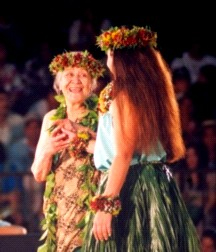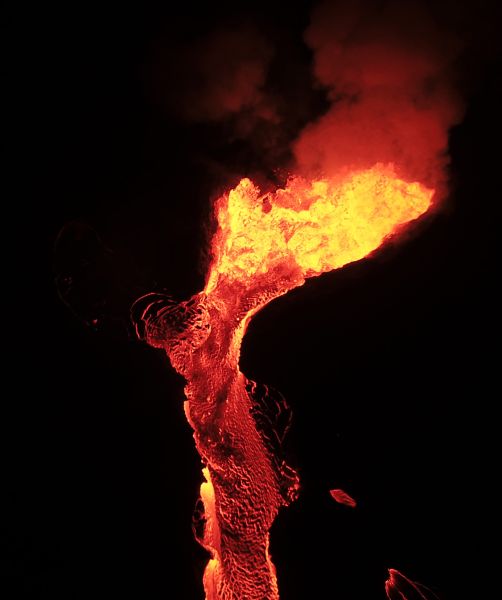Digital Collections
Celebrating the breadth and depth of Hawaiian knowledge. Amplifying Pacific voices of resiliency and hope. Recording the wisdom of past and present to help shape our future.
Kīhei de Silva
Haku mele: Traditional (words). Mae L. Loebenstein (additional words and music).
Sources: Joseph ʻĪIālāʻole (collector) and Kawena Pukui (translator), Mader Collection, MS Grp 81, 7.3, Bishop Museum Archives. (Chant.)
Mae L. Loebenstein, "Aia lā ʻo Pele i Hawaiʻi" lyric sheet given to me by Aunty Mae in December 1991. (Song.)
Discography: Kamehameha Sings: Golden Commemoration, Panini PS(2)-1001. (Chant.)
Mele Hula, Noelani NRS102. (Chant.)
George Nāʻope, The Golden Treasure, MDL Records MDL6402. (Chant.)
Emma Sharpe, Lahaina’s Fabulous Emma Sharpe, Tradewinds TS1120. (Chant.)
Keliʻi Tauʻa, The Pele Legends, Pumehana PS 4903. (Chant.)
Kaʻupena Wong and Pele Suganama, Mele Inoa, Poki SPC 9003. (Chant.)
Kawai Cockett, ʻO Kaʻōhao Kuʻu ʻĀina Nani, Hoʻolokahi HPC 203. (Song.)
Text below: As given by Mae L. Loebenstein and edited by Kīhei de Silva.
Translation: Kīhei de Silva. Italicized sections are those added to the original by Aunty Mae.
Aia lā ‘o Pele i Hawai‘i ‘eā
Ke ha‘a mai lā i Maukele ‘eā
‘Ūhī‘ūhā mai ana ‘eā
Ke nome a‘e lā iā Puna, ‘eā
‘Owaka i ka lani, nokenoke
Ē Pele ē Pele ē.
Ka mea nani ka i Paliuli ‘eā
Ke pulelo a‘e lā i nā pali ‘eā
Aia ka palena i Maui ‘eā
‘Āina o Kaululā‘au ‘eā
‘Owaka i ka lani, nokenoke
Ē Pele ē Pele ē.
I hea kāua e la‘i ai ‘eā?
I ka ‘ale nui a‘e li‘a nei ‘eā
'Ā i luna , 'ā i lalo, ne'ene'e ‘eā
‘O Pele ka wahine mai Kahiki ‘eā
‘Owaka i ka lani, nokenoke
Ē Pele ē Pele ē.
Ha‘ina ‘ia mai ka puana ‘eā
Aia lā ‘o Pele i Hawai‘i ‘eā
Ha‘ina hou mai ka puana ‘eā
No Hi‘iaka nō he inoa ‘eā
‘Owaka i ka lani, nokenoke
Ē Pele ē Pele ē.
Pele is in Hawai‘i
She is dancing at Maukele
She rumbles and mutters
As she consumes Puna.
Flashing in the heavens, on and on
O Pele, Pele.
The Beautiful One is at Paliuli
Rising over the cliffs
She is at the borders of Maui
Land of the chief Kaululā‘au
Flashing in the heavens, on and on
O Pele, Pele.
Where will we find peace?
On the great billows we love
Blazing above, blazing below, hitching along
Pele is the woman from Kahiki
Flashing in the heavens, on and on
O Pele, Pele.
This is the end of my song
Pele is in Hawai‘i
Tell again the refrain
In honor of Hi‘iaka
Flashing in the heavens, on and on
O Pele, Pele.
The traditional, chanted version of "Aia lā ʻo Pele" belongs to the collection of Joseph Keali‘iakamoku ‘Īlālā‘ole (1873–1965), one of the "last great Hawaiian chanters to have been born in the 19th century" (Elizabeth Tatar in Hawaiian Music and Musicians, 163–4). The integrity of his text—I have found no conflicting versions to cloud its pedigree—suggests that ‘Īlālā‘ole was his generation’s sole keeper and teacher of "Aia lā ‘o Pele." The structure and language of his text—the chant is built with neat, evenly phrased verses of two lines each; it ends with "Haʻina"; its allusions are recognizable, its vocabulary is familiar; and its grammar is listener-friendly—suggest that it belongs to the last decades of the 19th century. And the content of his text—a dancing, hissing, munching, floating journey that follows Pele down the southern flank of Mauna Loa from summit to sea, to sky, to Maui—suggests a late 19th century volcanic sequence of the kind described below:
‘Īlālā‘ole’s "Aia lā ‘o Pele" is filled with a sense of Pele’s presence, energy, and beauty. She is undeniably there in Hawaiʻi. She dances (ha‘a, a word for the dancing of gods and nature) in the verdant uplands of Maukele. She "rumbles and mutters," "puffs and blows," and "shishes and shushes" (all these phrases represent efforts to translate ‘ūhī‘ūhā, the sonorous breathing of the surging, molten fires of an eruption) as she munches inexorably through the district of Puna. She rises in beautiful fountains over the cliffs of Paliuli southwest of Kīlauea. And she reaches, her fingers glowing in the night sky, all the way to the borders of Maui. "Where," the chant asks "are we to find peace in all this activity?" The chant’s cryptic, insider’s answer—"In the billowing waves we love"—implies that Pele cannot be avoided by those who would share her home: if one lives with Pele, one must have a dancer’s balance, flexibility, and feel for a land whose very nature is change.
The tone of "Aia lā ‘ō Pele" is that of celebration and wonder, not resignation and dread, because it belongs to a people who, as Kawena Pukui reminds us:
did not fear or cringe before, or hate, the power and destructive violence of Mauna Loa. They took unto them this huge Mother mountain, measured their personal dignity and powers in terms of its majesty and drama . . . They loved Pele, whose home was their land: they endured her furies, and celebrated the drama of creation with which they lived so intimately . . . If Pele is not real to you, you cannot comprehend the quality of relationship that exists between persons related to and through Pele, and of these persons to the lands and phenomena, not "created by" but which are Pele and her clan. (Pukui, The Polynesian Family System in Ka‘ū, 22, 28.)
There is no peace (la‘i) to be had in the land of Pele if that word is construed to mean "sameness and predictability." Where do Pele’s people find peace? "Right here," the song says, "on this beloved, billowing ʻocean’ of liquid rock." Peace, for the people of "Aia lā ‘o Pele," is found in a philosophy that recognizes the sometimes chaotic nature of life and celebrates its beauty, vigor, and challenge.
We first heard "Aia lā ‘o Pele" in its modern, ‘auana form when Kawai Cockett sang it for us on a bus ride to Kīlauea Crater two days after the 1989 Merrie Monarch Festival. He explained that Aunty Mae Loebenstein had added a traditional refrain and concluding verse to the original mele, and had then put the resulting piece to music. He had sung "Aia lā ‘o Pele" for Hālau o nā Maoli Pua in the women’s ‘auana division of the 1983 Merrie Monarch when Aunty Mae was with that hālau; a highlight of the Maoli Pua performance, if we remember correctly, was the use of red lā‘ī skirts.
Because the older form of "Aia lā ‘o Pele" was taught to Māpuana de Silva by Aunty Lani (Nana) Kalama, who learned it with Aunty Maiki Aiu-Lake when they were with Lōkālia Montgomery, it is something that Māpu teaches exactly as she was taught and only to students who have earned, through effort, attitude, and longevity, the privilege of learning it. We did not enter frivolously, then, into our ‘auana relationship with Aunty Mae’s song; that decision was an especially careful one that was based on the intense appeal and integrity of her work. We asked for and received her permission to perform "Aia lā ‘o Pele" in the women’s ‘auana division of the 1992 Merrie Monarch. We were fascinated with the uplifting, gotta-dance quality of her music, and with the song’s ability to retain the spirit of the original. Our fascination has not waned one bit in the intervening years.
We believe that Aunty Mae’s work belongs to the tradition of late 19th and early 20th century hula ku‘i wherein older, chanted compositions were tastefully set to Western music—to guitar and ‘ukulele in particular—in a manner that complemented the content, phrasing, and rhythms of the original. Such mele as "Kalākaua he Inoa," "Lili‘u Ē," "Wahine Hololio," and "No ke Ano Ahiahi" belong to this ku‘i, or "joining," tradition. So, too, does the new-but-old "Aia lā ‘o Pele." Aunty Mae’s tune follows their words-first, enhance-not-overwhelm precedent. It is loyal to the lively, ipu-driven beat of the original; it lends itself to accurate and spirited phrasing; and it serves, as do the best musical compositions of the genre, to revitalize chants that might otherwise be forgotten or taken for granted. Above all, the ‘auana version of "Aia lā ‘o Pele" is both compliment and complement to the original because it is a hula composed for dancers by one who devoted her life to the dance.
The essay above was written by Kīhei de Silva and published in his book He Aloha Moku o Keawe: A Collection of Songs for Hawai‘i, Island of Keawe, Honolulu, 1997, pps. 20–22. It is offered here, in slightly revised and updated form, with his express consent. He retains all rights to this essay; no part of it may be used or reproduced without his written permission.

photo credit: Louie Lopez
Mae Loebenstein, beloved kumu hula, presents her niece Ulalia Woodside in the Miss Aloha Hula division of the 1994 Merrie Monarch Festival. Aunty Mae has said of her mother Ida Long, “The most precious gift [she] gave me through hula was a sense of discipline. Discipline developed assurance and confidence. Mama taught us hula as a way to know our culture and heritage rather than for entertaining.”

photo credit: U. S. Geological Survey
Pele continues to create new ʻāina in Puna, including this volcanic action at Fissure 8 in 2018. I hea kāua e laʻi ai?